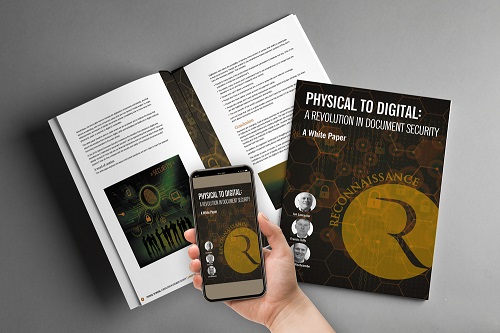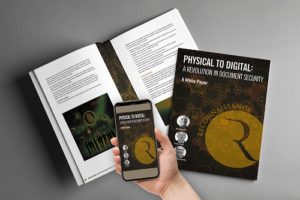
A new White Paper, which examines the implications of the transition from physical to digital security documents, has been published by Reconnaissance International.
 ‘Physical to Digital: A Revolution in Document Security’ considers the implications behind the current digital revolution in the areas of financial transactions and ID document security. The publication contrasts more than 1,000 years of experience in printing and examining security documents with the last three decades, which has seen a huge growth in the use of smartphones in what has previously been the domain of secured printed documents.
‘Physical to Digital: A Revolution in Document Security’ considers the implications behind the current digital revolution in the areas of financial transactions and ID document security. The publication contrasts more than 1,000 years of experience in printing and examining security documents with the last three decades, which has seen a huge growth in the use of smartphones in what has previously been the domain of secured printed documents.
Protection and security are seen as the primary drivers in the physical document world, while digital growth is being propelled by a ‘can we do it? And if so how?’ attitude, rather than security. Examples of breaches, hacks and outages in the digital world are included in the White Paper. A comparison reveals that in the Eurozone the incidence of payment card fraud is over 300 times bigger than the number of euro banknotes that are counterfeited.
The paper also considers how far the transition in security documents from the physical to digital has gone and what the future holds. It also questions how safe is the data that is held and used in the digital world, where we’re seeing data breaches that enable the theft of personal information about tens of millions of people. And whilst there is a recognition that society cannot turn the clock back, the White Paper nevertheless urges caution and the need to change the mindset of people working on digital finance and digital ID, to put data and personal security at the heart of this new world.
The White Paper concludes that the use of digital technologies has some way to go before replacing cash – most people in most countries continue to rely on cash for retail transactions. Similarly, when it comes to ID documents, digital technologies, while attractive, remain for the time being some way short of being ubiquitous.
It’s clear, says the Paper, that physical banknotes and ID credentials remain the norm, with the inspection of these documents by people and machines remaining the essential step in detecting fraudulent documents.
Ian Lancaster, founder and former managing director of Reconnaissance International and lead author and editor, said the White Paper is an important contribution to the digital document debate, clarifying the current position and the critical issues: “A digital revolution is taking place. We are moving from a world in which people can examine and inspect a document to check its legitimacy to one in which we are required to trust that a device, such as our smartphone, is doing what we think it’s doing.
“Is the data it’s using accurate and secure and is the decision it leads us to make correct and appropriate? Throughout all the issues and considerations this raises, we must ask the question: does digital make us and our data safe and secure?”
This White Paper sets out the issues for which Reconnaissance is creating discussion platforms, including the Digital Document Security conference, which takes place 5-7 October in Vienna, and an extended special report due for publication later this year, titled ‘Secure Documents: The Transition from Physical to Digital’.
A copy of ‘Physical to Digital: A Revolution in Document Security’ is available free to download.





